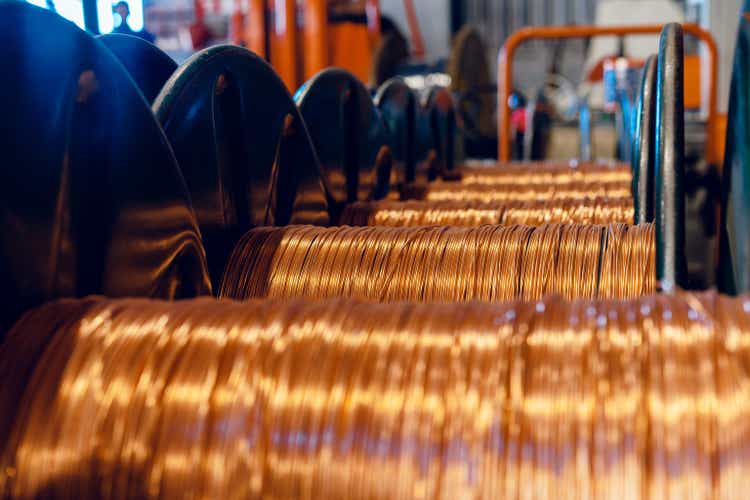FabrikaCr
Shares of Freeport-McMoRan (NYSE:FCX) have taken a move lower again, losing about half their value from the highs about a quarter ago. With Freeport being synonymous of copper, this move is highly noteworthy as shares fell to the lows over the past year. In the debate about raging inflation, concerns about slower economic growth, or a reversal thereof, are stalking fears among investors.
An Update
My last take on Freeport dates back to January 2019 as I concluded that there were tough times ahead as the company was hit by lower lucrative production in Indonesia, softer pricing and higher costs. This would likely take a beating on profitability in the near term and with few triggers on the horizon, the year was set to become a transition year.
This transition year came after Freeport has seen years of challenges with the business which includes a very painful round-trip investment in oil and gas properties in recent years, as the company closed a deal with the Indonesian government to “end” the continued discussions on that front, at a big cost in terms of a lower share of future profits. With copper prices having fallen from $3.00 per pound in 2018 to $2.70 per pound, there was a lot of pressure on the business.
The 2018 results at the time revealed a 13% increase in revenues to $18.6 billion, with operating earnings up a billion to $4.7 billion, as net earnings of $2.2 billion translated into earnings power of $1.50 per share, at a time when shares traded at just $11, creating a very compelling earnings multiple. This was ahead of the headwinds described above, of course.
A net debt load of $6.9 billion was manageable, with leverage coming in around 1 time based on 2018 EBITDA, yet results were softening amidst the combination of headwinds described above, as I believed that earnings could fall all the way to break-even levels, or thereabouts. While the near term was not too compelling, there was long-term potential if economies would grow stronger, prices would recover and the reliance on Indonesia would naturally come down, given the focus on non-Indonesian projects by the company.
What Happened?
After issuing this cautious, but long-term positive note on Freeport, we have seen shares trade flat around the $10 mark during the remainder of 2019. Shares initially moved lower following the outbreak of the pandemic, rallied to $25 by year-end 2021, hit a high of $50 in March of this year, and now are back to $26 again.
As it turned out, 2019 was tough with sales falling to $14.4 billion as operating challenges translated into a loss of $239 million, in line with my concerns at the start of the year. Revenues were flat in 2020, although they improved throughout the year, as cost savings resulted in net profits of $599 million that year. Despite the minimal profitability of $0.41 per share, shares rallied to $25 by year-end as the company has seen great operating momentum.
This showed up in the 2021 results, a year in which revenues rose spectacularly to $22.8 billion, as operating earnings rose to $8.3 billion, and net earnings rose to $4.3 billion, coming in at $2.90 per share. Following the great earnings power, the company has cut net debt to $1.4 billion. This was driven by average copper pricing topping $4.30 per pound, while production volumes rose and costs were under control. The strong results triggered the company into reinstating a $0.60 per share dividend again, as at $25, valuations were still not that demanding early in 2021.
And Now?
Despite the very strong results for 2021, with earnings trending at $3.00 per share, shares have sold off violently in recent times. The geopolitical events and inflationary concerns triggered a rally in copper prices to $5 per pound in spring, but by now copper prices have fallen very substantially, trading at just $3.30 per pound now, actually lower than the 2021 levels.
The first quarter results in April were still very strong as revenues came in at $6.6 billion on which earnings of $1.5 billion, or $1.04 per share, were reported, with net debt further curtailed to $1.3 billion. The issue is that this was based on quarterly production of a billion pounds of copper, sold at $4.60 per share as all such sales at a current price of $3.30 translates into $1.3 billion fewer quarterly revenues, and a huge shortfall in earnings as well of course.
With a current share count just below 1.5 billion shares, the market is still valuing Freeport at $39 billion here, but unlike the past days, it is the absence of large net debt which makes this number comparable to the enterprise valuation.
The truth is that the reversal from peak $5 prices to $3.30 per pound makes me very cautious, as the calculus above shows that this could wipe out pretty much all the earnings. So given this background, shares have held up quite well, although a 50% pullback in three months’ time is very severe and warrants a deeper look. Of course, the lower prices are mostly the result of concerns about economic growth, as the major culprit includes uncertainty on China and the pandemic of course.
While the copper cycle remains inherently volatile, I must say that I am positive on the long-term copper outlook given the EV and energy transition which provides long-term convenience, as fortunately, Freeport is very strong in terms of its balance sheet right now.
Still holding my original position at $11 early in 2019, which I trimmed largely in the low thirties during the run higher. I am happy to start initiating again at $26, as the reaction in the share price and copper prices seems a bit of an overreaction to me, although this remains a volatile environment and investment of course.


Be the first to comment